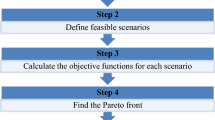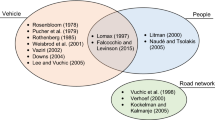Abstract
This paper concerns the definition of general rules for planning and decision making in the digitalization of a long distance telecommunications network. It is shown that, under some hypotheses, a network built around a transit centre may be decomposed into elementary triangular networks for which traffic routing and circuit routing are treated at the same time. In the proposed method the evolution in time of the existing network is optimized by minimizing the discounted cost and taking into account modularity constraints. In particular, using simple examples, the dependence of the transit threshold on the immediate environment is studied. Finally we show how the model may be used for setting up a network configurator.
Analyse
L’article propose des règles générales de planification et de décision pour l’implantation des techniques numériques dans un réseau interurbain de télécommunications. Il montre que, sous certaines hypothèses, un réseau construit autour d’un centre de transit peut être décomposé en réseaux triangulaires élémentaires pour lesquels on peut traiter simultanément l’acheminement et le routage. La méthode proposée optimise l’évolution au cours du temps du réseau existant, en minimisant le coût actualisé; elle permet d’intégrer des contraintes de modularité. On étudie notamment, à partir d’exemples simples, les variations du seuil de transit en fonction de l’environnement immédiat. On montre enfin comment le modèle peut être utilisé par la mise en place d’un configurateur de réseau.
Similar content being viewed by others
Bibliographie
Jarry-Lacombe (B.),Vidal-Majdar (A.),Matignon (G.). Traffic routing in a hybrid analog-digital network.Ann. Telecommunic., Fr. (sept.–oct. 1981),36, n∘ 9-10, pp. 521–537.
Minoux (M.). Optimisation et planification des réseaux de télécommunications. Proc. 7thIFIP, conf. on optimization techniques, Nice, 1975.
Elsner (W. B.). Dimensioning trunk groups for digital networks.Internat. Teletraffic Congress, Torremolinos, (oct. 1979), n∘ 9.
Mazzei (G.), Miranda (G.), Pallota (P.). On a full digital long-distance network.Internat. Teletraffic Congress. Torremolinos, (oct. 1979), n∘ 9.
Maury (J. P.),Gaucherelle (G.),Rousset (G.). Détermination par calculateur d’une stratégie d’acheminement optimale dans un réseau de télécommunications,Ann. Télécommunic., Fr. (sept.–oct. 1970),25, n∘ 9-10, pp. 349–360.
Author information
Authors and Affiliations
Additional information
Cet article correspond à la communication présentée au colloque «Planification des réseaux de télécommunications» à Paris, septembre 1980. Une version française est disponible auprès des auteurs.
Rights and permissions
About this article
Cite this article
Passeron, A., Spizzichino, A. A model for investigating the introduction of digital techniques based on a decomposition into elementary networks: methodology and first results. Ann. Télécommun. 36, 561–568 (1981). https://doi.org/10.1007/BF02995994
Received:
Accepted:
Issue Date:
DOI: https://doi.org/10.1007/BF02995994
Key words
- Telecommunication network
- Long distance network
- Planning
- Digitalization
- Modeling
- Economic optimization
- Meshed network




